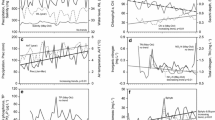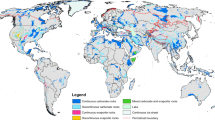Abstract
Paleolimnological analyses can be used to evaluate limnological responses to changing climate over decadal to centennial timescales, especially in regions with sparse lake monitoring data. We used a training set with 90 lakes to develop a diatom-based conductivity transfer function and address climate-driven changes in lakes on the Qinghai-Xizang Plateau, Tibet. This new training set is an expanded version of a previous model (Yang et al. in J Paleolimnol 30:1–19, 2003) and shows improved performance statistics for the conductivity model. The expanded training set also contains diatom species not previously identified from the region, such as Stephanodiscus sp. and Cyclotella sp., which are common eutrophic indicator species in other regions, but can also be influenced by water column conductivity. The new conductivity transfer function was applied to Lakes Nam Co and Chen Co in Tibet. Recent conductivity inferences were compared with climate data from the Dangxiong weather station and water level records from Yangzhuyong Co, which show increasing temperature and lower water levels, respectively, since AD 1960. Other studies showed that the water balance for many lakes on the Qinghai-Xizang Plateau is complex, affected by both evaporation and glacial melting. Our paleolimnological reconstructions, which include sediment particle size data, indicate that over relatively short timescales glacial meltwater can influence lake hydrology, but over decadal timescales, increases in evaporation, driven by rising temperatures, dominate. Our findings suggest that regional warming is lowering water levels at these sites and will continue to do so given predicted future climate warming.









Similar content being viewed by others
References
Adler S, Hubener T (2007) Spatial variability of diatom assemblages in surface lake sediments and its implications for transfer functions. J Paleolimnol 37:573–590
Appleby PG, Oldfield F (1983) The assessment of Pb-210 data from sites with varying sediment accumulation rates. Hydrobiologia 103:29–35
Battarbee RW (1986) Diatom analysis. In: Berglund BE (ed) Handbook of Holocene palaeoecology and palaeohydrology. Wiley, Chichester, pp 527–570
Battarbee RW, Jones VJ, Flower RJ, Cameron NG, Bennion H (2001) Diatoms. In: Smol JP, Birks HJB, Last WM (eds) Tracking environmental change using lake sediments. Kluwer, Dordrecht, pp 172–176
Birks HJB, Line JM, Juggins S, Stevenson AC, ter braak CJF (1990) Diatoms and pH reconstruction. Philos Trans R Soc B 327:263–278
Chen B, Chao WC, Liu X (2003) Enhanced climatic warming in the Tibetan Plateau due to doubling CO2: a model study. Clim Dyn 20:401–413
Chen GJ, Dalton C, Leira M, Taylor D (2008) Diatom-based total phosphorus (TP) and pH transfer functions for the Irish Ecoregion. J Paleolimnol 40:143–163
Fan H, Gasse F, Huc A, Li YF, Sifeddine A, Soulie-Marsche I (1996) Holocene environmental changes in Bangong Co basin (western Tibet). 3. biogenic remains. Palaeogeogr Palaeocl Palaeoecol 120:65–78
Fontes JC, Melieres F, Gibert E, Qing L, Gasse F (1993) Stable-isotope and radiocarbon balances of two Tibetan Lakes (Sumxi Co, Longmu Co) from 13,000-BP. Quat Sci Rev 12:875–887
Fritz SC (1990) 20th-century salinity and water-Level fluctuations in Devils Lake, North-Dakota—test of a diatom-based transfer-function. Limnol Oceanogr 35:1771–1781
Fritz SC (2007) Salinity and climate reconstruction from diatoms in continental lake deposits. In: Elias S (ed) Encyclopedia of quaternary science, vol 1. Elsevier, Oxford, pp 514–522
Fritz SC, Juggins S, Battarbee RW, Engstrom DR (1991) Reconstruction of past changes in salinity and climate using a diatom-based transfer-function. Nature 352:706–708
Gasse F, Fourtanier E (1991) African diatom paleoecology and biostratigraphy. J Afr Earth Sci 12:325–334
Gasse F, Arnold M, Fontes JC, Fort M, Gibert E, Huc A, Li BY, Li YF, Liu Q, Méliéres F, Vancampo E, Wang FB, Zhang QS (1991) A 13,000-year climate record from western Tibet. Nature 353:742–745
Gasse F, Juggins S, Khelifa LB (1995) Diatom-based transfer functions for inferring past hydrochemical characteristics of African lakes. Palaeogeogr Palaeocl Palaeoecol 117:31–54
Gasse F, Fontes JC, VanCampo E, Wei K (1996) Holocene environmental changes in Bangong Co basin (western Tibet). 4. discussion and conclusions. Palaeogeogr Palaeocl Palaeoecol 120:79–92
Gregory-Eaves I, Smol JP, Finney BP, Edwards ME (1999) Diatom-based transfer functions for inferring past climatic and environmental changes in Alaska, USA. Arct Antarct Alp Res 31:353–365
Hall RI, Smol JP (1996) Paleolimnological assessment of long-term water-quality changes in south-central Ontario lakes affected by cottage development and acidification. Can J Fish Aquat Sci 53:1–17
IPCC (2007) Climate change 2007: synthesis report. Contribution of working groups I, II and III to the fourth assessment report of the Intergovernmental Panel on Climate Change [Core Writing Team, Pachauri RK, Reisinger A (eds)]. IPCC, Geneva, Switzerland, 104 pp
Jongman RH, ter Braak CJF, Van Tongeren OFR (1995) Data analysis in community and landscape ecology. Cambridge University Press, Cambridge, 299 pp
Kashima K (2003) The quantitative reconstruction of salinity changes using diatom assemblages in inland saline lakes in the central part of Turkey during the Late Quaternary. Quat Int 105:13–19
Krammer K, Lange-Bertalot H (1988a) Bacillariophyceae. 2 Teil, Bacillariaceae, Epithemiaceae, Surirellaceae. Gustav Fischer, Stuttgart 596 pp
Krammer K, Lange-Bertalot H (1988b) Bacillariophyceae. 2/1 Teil, Naviculaceae. Gustav Fischer, Stuttgart 876 pp
Krammer K, Lange-Bertalot H (1991a) Bacillariophyceae. 3 Teil, Centrales, Fragilariaceae, Eunotiaceae. Gustav Fischer, Stuttgart 576 pp
Krammer K, Lange-Bertalot H (1991b) Bacillariophyceae. 4 Teil, Achnanthaceae, Kritische Ergänzungen zu Navicula (Lineolatae) und Gomphonema Gesamtliteraturverzeichnis Teil 1–4. Gustav Fischer, Stuttgart 437 pp
Krammer K, Lange-Bertalot H (2000) Bacillariophyceae. Part 5, English and French translation of the keys. Spectrum, Heidelberg 311 pp
Kutzbach JE, Prell WL, Ruddiman WF (1993) Sensitivity of Eurasian climate to surface uplift of the Tibetan Plateau. J Geol 101:177–190
Lepš J, Šmilauer P (2003) Multivariate analysis of ecological data using CANOCO. Cambridge University Press, Cambridge 269 pp
Li BY, Wang FB, Yang YC, Zhang QS (1982) On the paleogeographical evolution of Xizang (Tibet) in the Holocene. Geogr Res 1:26–36
Liu XD, Chen BD (2000) Climatic warming in the Tibetan Plateau during recent decades. Int J Climatol 20:1729–1742
Lu CX, Yu G, Xie GD (2005) Tibetan plateau serves as a water tower. IGARSS 2005: IEEE international geoscience and remote sensing symposium, pp 3120–3123
Manabe S, Terpstra TB (1974) Effects of mountains on general circulation of atmosphere as identified by numerical experiments. J Atmos Sci 31:3–42
Morrill C (2004) The influence of Asian summer monsoon variability on the water balance of a Tibetan lake. J Paleolimnol 32:273–286
Ramstack JM, Fritz SC, Engstrom DR, Heiskary SA (2003) The application of a diatom-based transfer function to evaluate regional water-quality trends in Minnesota since 1970. J Paleolimnol 29:79–94
Reavie ED, Hall RI, Smol JP (1995) An expanded weighted-averaging model for inferring past total phosphorus concentrations from diatom assemblages in Eutrophic British-Columbia (Canada) lakes. J Paleolimnol 14:49–67
Reed JM (1998) A diatom-conductivity transfer function for Spanish salt lakes. J Paleolimnol 19:399–416
Roberts D, McMinn A (1996) Relationships between surface sediment diatom assemblages and water chemistry gradients in saline lakes of the Vestfold Hills, Antarctica. Antarct Sci 8:331–341
Shen J, Liu XQ, Wang SM, Matsumoto R (2005) Palaeoclimatic changes in the Qinghai Lake area during the last 18,000 years. Quatern Int 136:131–140
Smol JP, Cumming BF (2000) Tracking long-term changes in climate using algal indicators in lake sediments. J Phycol 36:986–1011
Stoermer EF, Smol JP (1999) The diatoms: applications for the environmental and earth sciences. Cambridge University Press, Cambridge, 469 pp
ter Braak CJF (1987) The analysis of vegetation-environment relationships by canonical correspondence-analysis. Plant Ecol 69:69–77
ter Braak CJF, Juggins S (1993) Weighted Averaging Partial Least-Squares Regression (WA-PLS)—an improved method for reconstructing environmental variables from species assemblages. Hydrobiologia 269:485–502
ter Braak CJF, Šmilauer P (2002) CANOCO reference manual and CanoDraw for windows user’s guide: software for canonical community ordination (version 4.5). Microcomputer Power, Ithaca. www.canoco.com
Vancampo E, Gasse F (1993) Pollen-inferred and diatom-inferred climatic and hydrological changes in Sumxi Co basin (Western Tibet) since 13,000 yr BP. Quat Res 39:300–313
Walker IR, Cwynar LC (2006) Midges and palaeotemperature reconstruction—the North American experience. Quat Sci Rev 25:15
Wang SM, Dou HS (1998) Lakes in China. Science Press, Beijing (in Chinese)
Wang LH, Lu AX, Yao TD, Wang NL (2007) The study of typical glaciers and lakes fluctuations using remote sensing in Qinghai-Tibetan Plateau. Int Geosci Remote Sens 4526–4529
Wilson SE, Cumming BF, Smol JP (1996) Assessing the reliability of salinity inference models from diatom assemblages: an examination of a 219-lake data set from western North America. Can J Fish Aquat Sci 53:1580–1594
Wu YH, Zhu LP (2008) The response of lake-glacier variations to climate change in Nam Co Catchment, central Tibetan Plateau, during 1970–2000. J Geogr Sci 18:177–189
Wunsam S, Schmidt R, Klee R (1995) Cyclotella-taxa (Bacillariophyceae) in lakes of the Alpine region and their relationship to environmental variables. Aquat Sci 57:360–386
Yanai MH, Li CF, Song ZS (1992) Seasonal heating of the Tibetan Plateau and its effects on the evolution of the Asian summer monsoon. J Meteorol Soc Jpn 70:319–351
Yang XD, Kamenik C, Schmidt R, Wang SM (2003) Diatom-based conductivity and water-level inference models from eastern Tibetan (Qinghai-Xizang) Plateau lakes. J Paleolimnol 30:1–19
Yang XD, Wang SM, Kamenik C, Schmidt R, Shen J, Zhu LP, Li SF (2004) Diatom assemblages and quantitative reconstruction for paleosalinity from a sediment core of Chencuo Lake, southern Tibet. Sci China Ser D 47:522–528
Yang XD, Anderson NJ, Dong XH, Shen J (2008) Surface sediment diatom assemblages and epilimnetic total phosphorus in large, shallow lakes of the Yangtze floodplain: their relationships and implications for assessing long-term eutrophication. Freshw Biol 53:1273–1290
Yao T, Pu J, Lu A, Wang Y, Yu W (2007) Recent glacial retreat and its impact on hydrological processes on the Tibetan plateau, China, and surrounding regions. Arct Antarct Alp Res 39:642–650
Ye QH, Zhu LP, Zheng HP, Naruse RJ, Zhang XQ, Kang SC (2007) Glacier and lake variations in the Yamzhog Yumco basin, southern Tibetan Plateau, from 1980 to 2000 using remote-sensing and GIS technologies. J Glaciol 53:673–676
Ye QH, Yao TD, Chen F, Kang SC, Zhang XQ, Wang Y (2008) Response of glacier and lake covariations to climate change in Mapam Yumco basin on Tibetan plateau during 1974–2003. J China Univ Geosci 19:135–145
Zhu LP, Zhang PZ, Xia WL, Li BY, Chen L (2003) 1400-year cold/warm fluctuations reflected by environmental magnetism of a lake sediment core from the Chen Co, southern Tibet, China. J Paleolimnol 29:391–401
Zhu LP, Zhen XL, Wang JB, Lu HY, Xie MP, Kitagawa H, Possnert G (2009) A similar to 30,000-year record of environmental changes inferred from Lake Chen Co, Southern Tibet. J Paleolimnol 42:343–358
Acknowledgments
This study was supported by the National Basic Research Program of China (973 program, 2010CB950201) and the National Science Foundation of China (Grant No. 40772204). We are grateful to Dr. Yanling Li for help with diatom identification, to Weilan Xia for 210Pb dating, and to Hongxi Pan for chemical measurements. We particularly thank Richard Jones, Roland Schmidt, and two anonymous referees for their helpful comments on this study.
Author information
Authors and Affiliations
Corresponding author
Electronic supplementary material
Below is the link to the electronic supplementary material.
Rights and permissions
About this article
Cite this article
Wang, R., Yang, X., Langdon, P. et al. Limnological responses to warming on the Xizang Plateau, Tibet, over the past 200 years. J Paleolimnol 45, 257–271 (2011). https://doi.org/10.1007/s10933-011-9496-y
Received:
Accepted:
Published:
Issue Date:
DOI: https://doi.org/10.1007/s10933-011-9496-y




